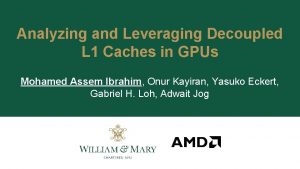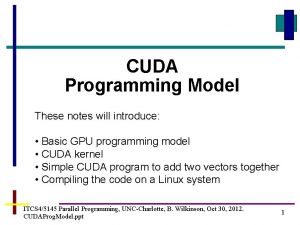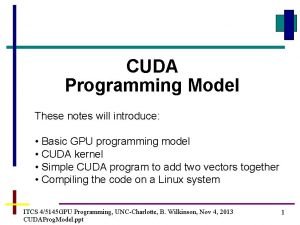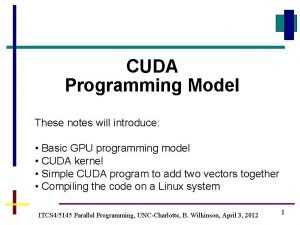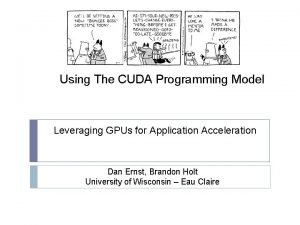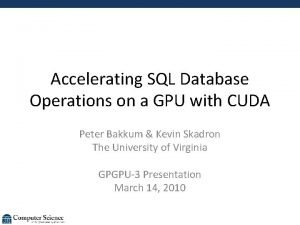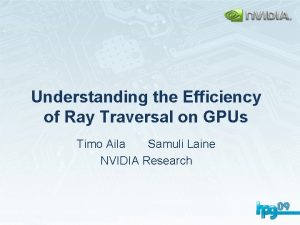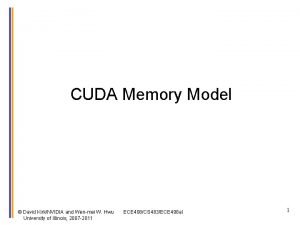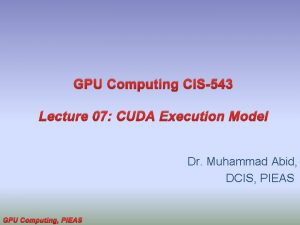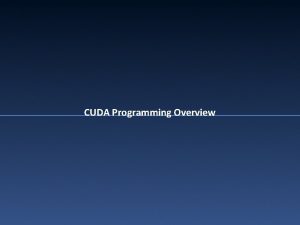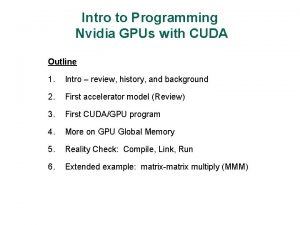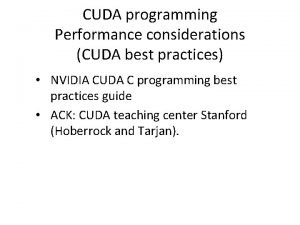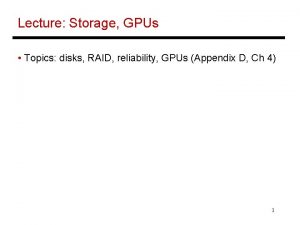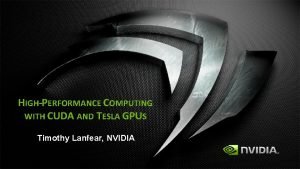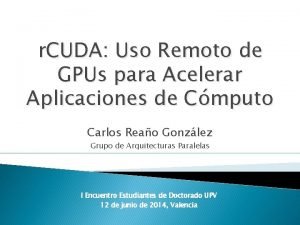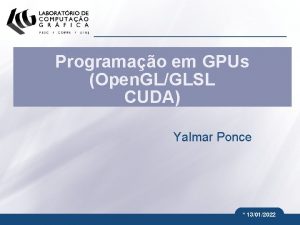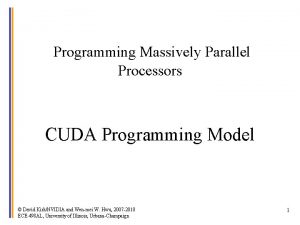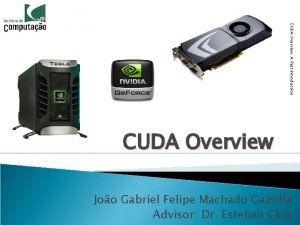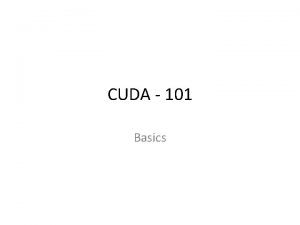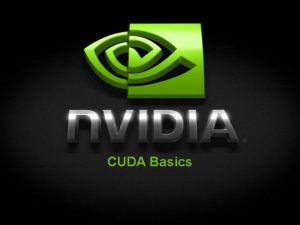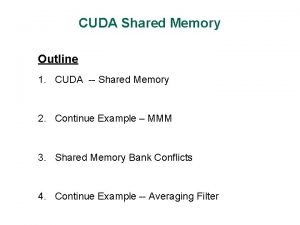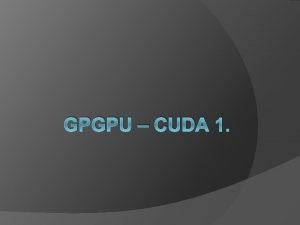Using The CUDA Programming Model Leveraging GPUs for






















































- Slides: 54

Using The CUDA Programming Model Leveraging GPUs for Application Acceleration Dan Ernst, Brandon Holt University of Wisconsin – Eau Claire

What is (Historical) GPGPU ? � General Purpose computation using GPU and graphics API in applications other than 3 D graphics � GPU accelerates critical path of application � Data parallel algorithms leverage GPU attributes Large data arrays, streaming throughput � Fine-grain SIMD parallelism � Low-latency floating point (FP) computation � � Applications – see GPGPU. org Game effects (FX) physics, image processing � Physical modeling, computational engineering, matrix algebra, convolution, correlation, sorting � 2

Why GPGPU Processing? �A quiet revolution Calculation: TFLOPS vs. 100 GFLOPS � Memory Bandwidth: ~10 x � � 3 GPU in every PC– massive volume and potential impact

Intel P 4 Northwood 4

NVIDIA GT 200 5

NVIDIA GT 200 6

Ge. Force 8800 (2007) Host Input Assembler Thread Execution Manager Parallel Data Cache Parallel Data Cache Texture Texture Texture Load/store Global Memory 7 Load/store

G 80 Characteristics � 367 GFLOPS peak performance (25 -50 times of current high-end microprocessors) � 265 GFLOPS sustained for apps such as VMD � Massively parallel, 128 cores, 90 W � Massively threaded, sustains 1000 s of threads per app � 30 -100 times speedup over high-end microprocessors on scientific and media applications: medical imaging, molecular dynamics � “I think they're right on the money, but the huge performance differential (currently 3 GPUs ~= 300 SGI Altix Itanium 2 s) will invite close scrutiny so I have to be careful what I say publically until I triple check those numbers. ” � 8 John Stone, VMD group, Physics, UIUC

Fermi (Earlier this year) ~1. 5 TFLOPS (SP)/~800 GFLOPS (DP) 140+ GB/s DRAM Bandwidth 9 ASCI Red – Sandia National Labs – 1997

NVIDIA Tesla C 2050 Card Specs � 448 GPU cores � 1. 15 GHz � Single precision floating point performance: 1030. 4 GFLOPs (2 single precision flops per clock per core) � Double precision floating point performance: 515. 2 GFLOPs (1 double precision flop per clock per core) � Internal RAM: 3 GB DDR 5 � Internal RAM speed: 144 GB/sec (compared 21 -25 GB/sec for regular RAM) � Has to be plugged into a PCIe slot (at most 8 GB/sec) 10

NVIDIA Tesla S 2050 Server Specs � 4 C 2050 cards inside a 1 U server (looks like a Sooner node) � 1. 15 GHz � Single Precision (SP) floating point performance: 4121. 6 GFLOPs � Double Precision (DP) floating point performance: 2060. 8 GFLOPs � Internal RAM: 12 GB total (3 GB per GPU card) � Internal RAM speed: 576 GB/sec aggregate � Has to be plugged into two PCIe slots (at most 16 GB/sec) 11

Compare x 86 vs S 2050 � Let’s compare the best dual socket x 86 server today vs Dual socket, AMD NVIDIA Tesla S 2050. 2. 3 GHz 12 -core Peak DP FLOPs 220. 8 GFLOPs DP 2060. 8 GFLOPs DP (9. 3 x) Peak SP FLOPS 441. 6 GFLOPs SP 4121. 6 GFLOPs SP (9. 3 x) Peak RAM BW 25 GB/sec 576 GB/sec (23 x) Peak PCIe BW N/A 16 GB/sec Needs x 86 server to attach to? No Yes Power/Heat ~450 W ~900 W + ~400 W (~2. 9 x) Code portable? Yes No (CUDA) Yes (PGI, Open. CL) 12

Compare x 86 vs S 2050 � Here are some interesting measures: Dual socket, AMD 2. 3 GHz 12 -core NVIDIA Tesla S 2050 DP GFLOPs/Watt ~0. 5 GFLOPs/Watt ~1. 6 GFLOPs/Watt (~3 x) SP GFLOPS/Watt ~1 GFLOPs/Watt ~3. 2 GFLOPs/Watt (~3 x) DP GFLOPs/sq ft ~590 GFLOPs/sq ft ~2750 GFLOPs/sq ft (4. 7 x) SP GFLOPs/sq ft ~1180 GFLOPs/sq ft ~5500 GFLOPs/sq ft (4. 7 x) Racks per PFLOP DP 142 racks/PFLOP DP 32 racks/PFLOP DP (23%) Racks per PFLOP SP 71 racks/PFLOP SP 16 racks/PFLOP SP (23%) OU’s Sooner is 34. 5 TFLOPs DP, which is just over 1 rack of S 2050. 13

Previous GPGPU Constraints � Dealing with graphics API � Working with the corner cases of the graphics API � Essentially – re-write entire program as a collection of shaders and polygons Input Registers Fragment Program per thread per Shader per Context Texture Constants Temp Registers Output Registers FB 14 Memory

CUDA � “Compute Unified Device Architecture” � General purpose programming model User kicks off batches of threads on the GPU � GPU = dedicated super-threaded, massively data parallel co-processor � � Targeted � software stack Compute oriented drivers, language, and tools � Driver for loading computation programs onto GPU 15

Parallel Computing on a GPU � 400 -series GPUs deliver 450 to 1, 400+ GFLOPS on compiled parallel C applications � Available in laptops, desktops, and clusters Ge. Force GTX 460 GPU parallelism is doubling every year � Programming model scales transparently � Programmable in C with CUDA tools � Multithreaded SPMD model uses application data parallelism and thread parallelism � Tesla S 1070 Tesla M 2050 16

Overview � CUDA � Basic � CUDA programming model concepts and data types application programming interface (API) basics �A couple of simple examples � Performance 17 features will be covered this afternoon

CUDA Devices and Threads �A CUDA compute device Is a coprocessor to the CPU or host � Has its own DRAM (device memory) � Runs many threads in parallel � Is typically a GPU but can also be another type of parallel processing device � � Data-parallel portions of an application are expressed as device kernels which run on many threads � Differences between GPU and CPU threads � GPU threads are extremely lightweight � Very � little creation overhead GPU needs 1000 s of threads for full efficiency � Multi-core 18 CPU needs only a few (and is hurt by having too many)

CUDA – C with a Co-processor � One program, two devices � Serial or modestly parallel parts in host C code � Highly parallel parts in device kernel C code Serial Code (host) Parallel Kernel (device) Kernel. A<<< n. Blk, n. Tid >>>(args); . . . Serial Code (host) Parallel Kernel (device) Kernel. B<<< n. Blk, n. Tid >>>(args); 19 . . .

Extended C

Buzzword: Kernel � In CUDA, a kernel is code (typically a function) that can be run inside the GPU. � The kernel code runs on the many stream processors in the GPU in parallel. � Each processor runs the code over different data (SPMD) 21

Buzzword: Thread � In CUDA, a thread is an execution of a kernel with a given index. � Each thread uses its index to access a specific subset of the data, such that the collection of all threads cooperatively processes the entire data set. � Think: 0 1 2 3 4 5 6 7 MPI Process ID � These are very much like threads in Open. MP � thread. ID they even have shared and private variables. … float x = input[thread. ID]; float y = func(x); output[thread. ID] = y; … � So what’s the difference with CUDA? � Threads are free 22

Buzzword: Block � In CUDA, a block is a group of threads. � Blocks are used to organize threads into manageable chunks. � Can organize threads in 1 D, 2 D, or 3 D arrangements � What best matches your data? � Some restrictions, based on hardware � Threads within a block can do a bit of synchronization, if necessary. 23

Buzzword: Grid � In CUDA, a grid is a group of blocks � no synchronization at all between the blocks. � Grids are used to organize blocks into manageable chunks. � Can organize blocks in 1 D or 2 D arrangements � What best matches your data? �A Grid is the set of threads created by a call to a CUDA kernel 24

Mapping Buzzwords to GPU Hardware � Grids map to GPUs � Blocks map to the Multi. Processors (MP) � Blocks are never split across MPs, but an MP can have multiple blocks � Threads map to Stream Processors (SP) � Warps are groups of (32) threads that execute simultaneously � Completely forget about these until later Image Source: NVIDIA CUDA Programming Guide

Transparent Scalability � Hardware is free to assign blocks to any SM (processor) �A kernel scales across any number of parallel processors Device Kernel grid Device Block 0 Block 1 Block 2 Block 3 Block 0 Block 1 Block 4 Block 5 Block 6 Block 7 Block 2 Block 3 Block 4 Block 5 Block 6 Block 7 26 time Block 0 Block 1 Block 2 Block 3 Block 4 Block 5 Block 6 Block 7 Each block can execute in any order relative to other blocks.

Block IDs and Thread IDs � Each thread uses IDs to decide what data to work on Block. Idx: 1 D or 2 D � Thread. Idx: 1 D, 2 D, or 3 D � � Simplifies memory addressing when processing multidimensional data Image processing � Solving PDEs on volumes �… � 27

CUDA Memory Model Overview � Global memory � Main means of communicating R/W Data between host and device � Contents visible to all threads � Long latency access � We will focus on global memory for now � Other later 28 Note: This is not hardware! Grid Block (0, 0) Block (1, 0) Shared Memory Registers Thread (0, 0) Thread (1, 0) memories will come Host Registers Thread (0, 0) Thread (1, 0) Global Memory

CUDA Device Memory Allocation � cuda. Malloc() � Allocates object in the device Global Memory � Requires two parameters � Address of a pointer to the allocated object � Size of of allocated object � cuda. Free() � Frees object from device Global Memory � Pointer 29 to freed object

CUDA Device Memory Allocation (cont. ) � Code example: � Allocate a 64 * 64 single precision float array � Attach the allocated storage to pointer named Md � “d” is often used in naming to indicate a device data structure TILE_WIDTH = 64; float* Md; int size = TILE_WIDTH * sizeof(float); cuda. Malloc((void**)&Md, size); cuda. Free(Md); 30

The Physical Reality Behind CUDA CPU (host) GPU w/ local DRAM (device) 31

CUDA Host-Device Data Transfer � cuda. Memcpy() � memory data transfer � Requires four parameters Grid to destination � Pointer to source � Number of bytes copied � Type of transfer Block (0, 0) Block (1, 0) Shared Memory � Pointer Host to Device to Host Device to Device � Asynchronous 32 transfer Registers Thread (0, 0) Thread (1, 0) Host Registers Thread (0, 0) Thread (1, 0) Global Memory

CUDA Host-Device Data Transfer (cont. ) � Code example: � Transfer a 64 * 64 single precision float array � M is in host memory and Md is in device memory � cuda. Memcpy. Host. To. Device and cuda. Memcpy. Device. To. Host are symbolic constants cuda. Memcpy(Md, M, size, cuda. Memcpy. Host. To. Device); cuda. Memcpy(M, Md, size, cuda. Memcpy. Device. To. Host); 33

CUDA Kernel Template � In C: void foo(int a, float b) { // slow code goes here } � In CUDA: __global__ void foo(int a, float b) { // fast code goes here! }

Calling a Kernel Function �A kernel function must be called with an execution configuration: __global__ void Kernel. Func(. . . ); dim 3 Dim. Grid(100, 50); Dim. Block(4, 8, 8); Kernel. Func(. . . ); 35 // 5000 thread blocks // 256 threads per block // invoke a function

Calling a Kernel Function �A kernel function must be called with an execution configuration: Declare the dimensions for grid/blocks __global__ void Kernel. Func(. . . ); dim 3 Dim. Grid(100, 50); Dim. Block(4, 8, 8); Kernel. Func(. . . ); 36 // 5000 thread blocks // 256 threads per block // invoke a function

Calling a Kernel Function �A kernel function must be called with an execution configuration: Declare the dimensions for grid/blocks __global__ void Kernel. Func(. . . ); dim 3 Dim. Grid(100, 50); Dim. Block(4, 8, 8); // 5000 thread blocks // 256 threads per block Kernel. Func<<<Dim. Grid, Dim. Block>>>(. . . ); //invoke a kernel � Any call to a kernel function is asynchronous from CUDA 1. 0 on, explicit synch needed for blocking 37

C SAXPY void saxpy_serial(int n, float a, float *x, float *y) { int i; for(i=0; i < n; i++) { y[i] = a*x[i] + y[i]; } } … //invoke the kernel saxpy_serial(n, 2. 0, x, y); 38

SAXPY on a GPU � Doing anything across an entire vector is perfect for massively parallel computing. � Instead of one function looping over the data set, we’ll use many threads, each doing one thread. ID calculation 0 1 2 3 4 5 6 7 … y[tid] = a*x[tid] + y[tid]; … 39

CUDA SAXPY __global__ void saxpy_cuda(int n, float a, float *x, float *y) { int i = (block. Idx. x * block. Dim. x) + thread. Idx. x; if(i < n) y[i] = a*x[i] + y[i]; } … int nblocks = (n + 255) / 256; //invoke the kernel with 256 threads per block saxpy_cuda<<<nblocks, 256>>>(n, 2. 0, x, y); 40

Matrix Multiplication in CUDA A case study

Matrix Multiplication: A Case Study � Matrix multiplication illustrates many of the basic features of memory and thread management in CUDA � Usage of thread/block IDs � Memory data transfer between host and device � Motivates some performance issues: � shared memory usage � register usage � Assumptions: � Basic unoptimized sgemm � Matrices are square (for simplicity) 42

Programming Model: Square Matrix Multiplication Example =M*N � Each � Basic � One is of size WIDTH x WIDTH N Idea: WIDTH �P thread calculates one element of P �M and N are loaded WIDTH times from global memory P WIDTH M 43 WIDTH

Step 1: Matrix Multiplication A Simple Host Version in C // Matrix multiplication on the (CPU) host in double precision 44 WIDTH N WIDTH k P WIDTH void Matrix. Mul. On. Host(float* M, float* N, float* P, int WIDTH) { int i, j, k; double a, b, sum; j for (i = 0; i < WIDTH; ++i) for (j = 0; j < WIDTH; ++j) { sum = 0; for (k = 0; k < WIDTH; ++k) { a = M[i * WIDTH + k]; M b = N[k * WIDTH + j]; sum += a * b; i } P[i * WIDTH + j] = sum; } } k WIDTH

Step 2: Input Matrix Data Transfer (Host-side Code) void Matrix. Mul. On. Device(float* M, float* N, float* P, int WIDTH) { int size = WIDTH * sizeof(float); float* Md, Nd, Pd; … // 1. Allocate and Load M, N to device memory cuda. Malloc(&Md, size); cuda. Memcpy(Md, M, size, cuda. Memcpy. Host. To. Device); cuda. Malloc(&Nd, size); cuda. Memcpy(Nd, N, size, cuda. Memcpy. Host. To. Device); // Allocate P on the device cuda. Malloc(&Pd, size); 45

Step 3: Output Matrix Data Transfer (Host-side Code) // 2. Kernel invocation code – to be shown later … // 3. Read P from the device cuda. Memcpy(P, Pd, size, cuda. Memcpy. Device. To. Host); // Free device matrices cuda. Free(Md); cuda. Free(Nd); cuda. Free (Pd); } 46

Step 4: Kernel Function __global__ void Matrix. Mul. Kernel(float* Md, float* Nd, float* Pd, int WIDTH) { float Pvalue = 0; k WIDTH for (int k = 0; k < WIDTH; ++k) { float Melement = Md[thread. Idx. y*WIDTH+k]; float Nelement = Nd[k*WIDTH+thread. Idx. x]; Pvalue += Melement * Nelement; } Nd tx Pd[thread. Idx. y*WIDTH+thread. Idx. x] = Pvalue; } Md Pd ty tx k 47 WIDTH ty WIDTH

Step 5: Kernel Invocation (Host-side Code) // Setup the execution configuration dim 3 dim. Grid(1, 1); dim 3 dim. Block(WIDTH, WIDTH); // Launch the device computation threads! Matrix. Mul. Kernel<<<dim. Grid, dim. Block>>>(Md, Nd, Pd, WIDTH); 48

Only One Thread Block Used � One Block of threads compute the matrix Pd � � Each thread computes one element of the matrix Pd Each thread � � � Nd Block 1 Thread (2, 2) Loads a row of matrix Md Loads a column of matrix Nd Perform one multiply and addition for each pair of Md and Nd elements � Compute to off-chip memory access ratio close to 1: 1 (not very good) � Size of matrix limited by the number of threads allowed in a thread block (512) 49 Grid 1 48 WIDTH Md Pd

Block IDs and Thread IDs � Each thread uses IDs to decide what data to work on Block ID: 1 D or 2 D � Thread ID: 1 D, 2 D, or 3 D � � Simplifies memory addressing when processing multidimensional data Image processing � Solving PDEs on volumes �… � 50

Matrix Multiplication Using Multiple Blocks bx 0 1 2 tx 0 1 2 TILE_WIDTH-1 Nd Pd into tiles � Each block calculates one tile WIDTH � Break-up � Each thread calculates one element � Block size equal tile size Md Pd 1 ty Pdsub TILE_WIDTH-1 TILE_WIDTH 51 2 WIDTH by 0 1 2 TILE_WIDTHE 0

Revised mmult Kernel using Multiple Blocks __global__ void Matrix. Mul. Kernel(float* Md, float* Nd, float* Pd, int Width) { // Calculate the row index of the Pd element and M int Row = block. Idx. y*TILE_WIDTH + thread. Idx. y; // Calculate the column idenx of Pd and N int Col = block. Idx. x*TILE_WIDTH + thread. Idx. x; float Pvalue = 0; // each thread computes one element of the block sub-matrix for (int k = 0; k < Width; ++k) Pvalue += Md[Row*Width+k] * Nd[k*Width+Col]; Pd[Row*Width+Col] = Pvalue; } 52

G 80 Block Granularity Considerations Q: For Matrix Multiplication using multiple blocks, should I use 8 x 8, 16 x 16 or 32 x 32 blocks? � For 8 x 8, we have 64 threads per Block. Since each SM can take up to 768 threads, there are 12 Blocks. However, each SM can only take up to 8 Blocks, only 512 threads will go into each SM! � For 16 x 16, we have 256 threads per Block. Since each SM can take up to 768 threads, it can take up to 3 Blocks and achieve full capacity unless other resource considerations overrule. � For 53 32 x 32, we have 1024 threads per Block. Not even one can fit into an SM!

Exercise: Area Under the Curve cp -r ~ernstdj/NCSI 2010. go to “cuda_trap” directory. less README. txt 54
 Analyzing and leveraging decoupled l1 caches in gpus
Analyzing and leveraging decoupled l1 caches in gpus Cuda programming model
Cuda programming model Cuda programming model
Cuda programming model Cuda programming model
Cuda programming model Cuda
Cuda Sql on gpus
Sql on gpus Understanding the efficiency of ray traversal on gpus
Understanding the efficiency of ray traversal on gpus Fast bvh construction on gpus
Fast bvh construction on gpus Cuda memory model
Cuda memory model Cuda execution model
Cuda execution model Multidomestic strategy pros and cons
Multidomestic strategy pros and cons Line extension vs brand extension
Line extension vs brand extension Leveraging social media for talent acquisition
Leveraging social media for talent acquisition Secondary source of brand knowledge
Secondary source of brand knowledge Secondary brand associations
Secondary brand associations Secondary association of brands
Secondary association of brands Coso three lines of defense
Coso three lines of defense Three lines of defense
Three lines of defense Leveraging educational assistance partnership
Leveraging educational assistance partnership Leveraging threat intelligence
Leveraging threat intelligence Leveraging network effects
Leveraging network effects The strategy of international business chapter 13
The strategy of international business chapter 13 Search by image
Search by image Perbedaan linear programming dan integer programming
Perbedaan linear programming dan integer programming Greedy algorithm vs dynamic programming
Greedy algorithm vs dynamic programming What is in system programming
What is in system programming Integer programming vs linear programming
Integer programming vs linear programming Definisi integer
Definisi integer Fspos vägledning för kontinuitetshantering
Fspos vägledning för kontinuitetshantering Typiska novell drag
Typiska novell drag Nationell inriktning för artificiell intelligens
Nationell inriktning för artificiell intelligens Returpilarna
Returpilarna Varför kallas perioden 1918-1939 för mellankrigstiden?
Varför kallas perioden 1918-1939 för mellankrigstiden? En lathund för arbete med kontinuitetshantering
En lathund för arbete med kontinuitetshantering Kassaregister ideell förening
Kassaregister ideell förening Personlig tidbok för yrkesförare
Personlig tidbok för yrkesförare A gastrica
A gastrica Densitet vatten
Densitet vatten Datorkunskap för nybörjare
Datorkunskap för nybörjare Tack för att ni lyssnade bild
Tack för att ni lyssnade bild Att skriva en debattartikel
Att skriva en debattartikel Delegerande ledarskap
Delegerande ledarskap Nyckelkompetenser för livslångt lärande
Nyckelkompetenser för livslångt lärande Påbyggnader för flakfordon
Påbyggnader för flakfordon Tryck formel
Tryck formel Svenskt ramverk för digital samverkan
Svenskt ramverk för digital samverkan Jag har nigit för nymånens skära
Jag har nigit för nymånens skära Presentera för publik crossboss
Presentera för publik crossboss Argument för teckenspråk som minoritetsspråk
Argument för teckenspråk som minoritetsspråk Vem räknas som jude
Vem räknas som jude Klassificeringsstruktur för kommunala verksamheter
Klassificeringsstruktur för kommunala verksamheter Luftstrupen för medicinare
Luftstrupen för medicinare Bästa kameran för astrofoto
Bästa kameran för astrofoto Centrum för kunskap och säkerhet
Centrum för kunskap och säkerhet Programskede byggprocessen
Programskede byggprocessen
